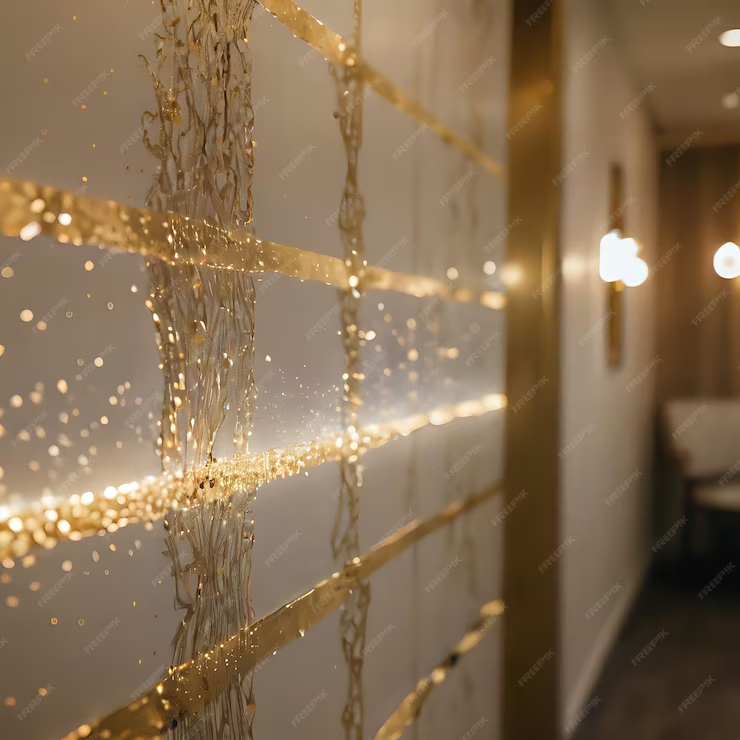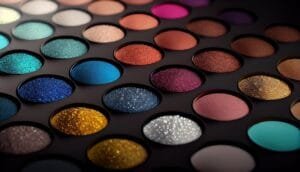Introduction to Glitter Effects
Glitter effects have transcended their initial use in the realm of arts and crafts, becoming a staple in various contexts such as home decor, fashion, and even digital art. The shimmering appeal of glitter can transform ordinary items into extraordinary creations, captivating the attention of individuals across different age groups and backgrounds. Whether it is a simple craft project, an elaborate fashion ensemble, or a digital artwork, the application of glitter brings an element of delight and creativity that is difficult to resist.
The popularity of glitter effects can be attributed to their visual impact and emotional resonance. Glitter serves not just as a decorative element but as a symbol of celebration and joy. Events such as weddings, birthdays, and holidays often incorporate glitter to enhance the festive atmosphere, adding a sparkle that reflects happiness and excitement. This transformative quality of glitter allows it to evoke feelings of nostalgia and wonder, making it a favored choice among artists and designers alike.
In the world of home decor, for example, mithila paints—often characterized by intricate designs and vibrant colors—can be complemented with glittery accents. This combination not only beautifies a space but also communicates a sense of warmth and welcoming. In fashion, glitter effects can elevate garments, turning them into statement pieces that express individuality and flair. Additionally, in digital art, the use of glitter textures can provide depth and dynamism, attracting viewers’ attention and enhancing the overall storytelling of the artwork.
All in all, the allure of glitter effects lies in their ability to engage the senses and inspire creativity. As artists and designers continue to explore new realms of expression, it is clear that glitter will remain a vital component, embodying the spirit of innovation and artistry across different domains.

Types of Glitter: A Comprehensive Guide
Glitter is a versatile material that can significantly enhance various creative projects. Understanding the different types of glitter available can help you make informed decisions for your artistic endeavors. The primary categories include fine, chunky, holographic, and metallic glitters, each offering unique attributes and applications.
Fine glitter consists of very small particles, resulting in a smooth and uniform application. It is ideal for projects that require a subtle sheen, such as card making or detailing on paintings. Fine glitter is particularly useful in techniques that involve layering, as it blends seamlessly into surfaces and can create soft, delicate effects without overwhelming the visual balance of the artwork.
In contrast, chunky glitter features larger particles, creating bold textures and vibrant visual appeal. This type is perfect for crafts where dramatic effects are desired, such as in home decor projects or costume embellishments. The pronounced reflective quality of chunky glitter ensures that it captures attention and adds an element of excitement to any creation, making it a popular choice for festive occasions and celebrations.
Holographic glitter stands out for its unique light-reflecting characteristics. When viewed from different angles, it produces a spectrum of colors, offering a dynamic and eye-catching finish. This type of glitter is often used in fashion and design projects to create an opulent and dazzling effect. Artists frequently incorporate holographic glitter in mithila paints to enrich traditional styles, adding a modern twist while maintaining cultural integrity.
Metallic glitter, on the other hand, is known for its shiny, reflective quality. It typically features a rich color palette, providing a striking visual impact. Suitable for both casual and formal applications, metallic glitter is often featured in party decorations and sophisticated art pieces. By selecting the appropriate type of glitter for your project, you can achieve the desired aesthetic, whether it’s subtle elegance or bold vibrancy.

Gathering Your Supplies: What You Need for a Glitter Project
Creating stunning glitter effects requires careful preparation and a specific set of supplies that cater to your project needs. The first essential component is adhesive, which comes in various forms. Glitter projects can benefit from wet glue, spray adhesive, or glue sticks, depending on the application and the materials you are using. For larger surfaces, a spray adhesive can provide an even coat, while a liquid glue allows for more precise application on intricate designs.
Next, consider the application tools at your disposal. Brushes are fundamental for distributing glue evenly across surfaces, ensuring an adequate base for the mithila paints and glitter to adhere effectively. For broader strokes, foam brushes or sponges can help apply adhesive uniformly. Pairing these with tools like tweezers can be beneficial for placing larger pieces of glitter meticulously without mess.
Regarding the surface materials, it is important to select sturdy substrates that are compatible with the adhesive you choose. Options include paper, canvas, and various fabrics, which can all provide different aesthetics to your final piece. When working with glitter, consider the texture and absorbency of the surface, as these factors can influence the adhesion and appearance of the glitter. If combining mithila paints with glitter, ensure the colors and textures complement one another for a cohesive look.
It is also critical to prioritize safety while working on glitter projects. Incorporate a well-ventilated area to minimize inhalation risks associated with loose glitter and adhesives. Consider wearing a mask and gloves to protect your respiratory system and skin from any irritation. With these supplies in hand, you are well-prepared to create dazzling glitter effects that enhance your artistic endeavors.
Techniques for Applying Glitter: Step-by-Step Methods
Applying glitter can transform a simple craft project into an eye-catching masterpiece. Understanding the various methods to apply glitter effectively is essential for achieving stunning results. This guide will provide step-by-step instructions suitable for both beginners and experienced crafters.
1. Applying Glitter to Wet Adhesive: One of the most straightforward methods is to apply glitter directly onto a wet adhesive. Begin by selecting a base material, such as cardstock or canvas. Apply a generous layer of adhesive, ensuring even coverage. Immediately sprinkle glitter over the wet adhesive, allowing it to stick. For best results, shake off any excess glitter once the adhesive is set. This technique provides a uniform glitter surface and is ideal for creating solid glitter layers.
2. Layering Methods: Layering different colors or types of glitter can create depth and dimension in your designs. Start with a base layer of adhesive on your chosen craft surface. Apply a light coat of the first color glitter and allow it to dry. Once dry, add another layer of adhesive and sprinkle a contrasting color on top. This method works well for projects like greeting cards or scrapbook pages, as it produces a visually striking effect that draws attention.
3. Creating Gradient Glitter Effects: Achieving a gradient effect with glitter adds a sophisticated touch to any project. Begin at one end of your craft surface by applying a heavier layer of adhesive and sprinkling a coarse glitter. As you move toward the opposite end, gradually decrease the amount of adhesive and switch to a finer glitter. This gradual transition in sparkle creates a beautiful ombre effect, perfect for items like party decorations or festive attire.
By utilizing these methods, crafters can master the art of applying mithila paints and glitter, ensuring their projects shine with creativity and elegance. Each technique not only enhances the aesthetic but also fosters a sense of accomplishment in the crafting process.

Creating Glitter Effects in Home Decor
Incorporating glitter into home decor can transform ordinary spaces into stunning visual experiences. Whether you’re aiming for a touch of elegance or a playful vibe, mithila paints or similar shimmering finishes can be the perfect solution. One popular idea is to embellish picture frames with glitter. A simple wooden frame can be upgraded by applying adhesive and coating it with glitter in a color that complements the artwork. This adds a unique and eye-catching detail to your wall displays.
Another innovative approach is to create an accent wall using mithila paints infused with fine glitter. This design not only enhances the aesthetic appeal of the room but also plays with light, creating a dynamic atmosphere. To achieve this effect, select a muted base color and complement it with a glitter that matches or contrasts elegantly, ensuring a cohesive look throughout the space. It is crucial to test a small area to see how the colors work together before committing to a larger application.
During festive seasons, glitter can play a pivotal role in centerpieces. Utilizing shimmering materials can enhance any gathering, from holiday dinners to birthday parties. Create festive arrangements using glass vases filled with glittered stones, or opt for DIY candle holders decorated with mithila paints that showcase sparkling designs. Remember to coordinate glitter colors with your existing decor to create harmony. For instance, if your dining room features earthy tones, consider using gold or copper glitter for an elegant touch, while brighter shades can enliven a contemporary space.
Ultimately, incorporating glitter into home decor is about balancing creativity and sophistication. The key is to use mithila paints or similar products that enhance existing elements without overwhelming them. By carefully selecting where and how to apply glitter, you can achieve a beautiful and inviting atmosphere in your home.

Using Glitter in Fashion and Make-Up
Glitter has long been a favored embellishment in the realms of fashion and make-up, providing a unique and eye-catching sparkle to various creations. The versatile nature of glitter caters to a wide demographic and style, making it a popular choice for both everyday wear and special occasions. In terms of apparel, glitter can transform the simplest garments into show-stopping pieces. Designers often incorporate glittered fabrics or use mithila paints adorned with shimmering particles to give a contemporary twist to traditional dresses. From dazzling sequined tops to glitter-infused shoes, these elements provide an alluring aesthetic that can elevate any outfit.

In the realm of accessories, glitter plays a crucial role in enhancing personal style. Accessories such as clutches, earrings, and hairpieces enriched with glitter can add a touch of glam to any outfit. Hair accessories, in particular, have seen an explosion of creativity with glitter-based designs ranging from hairpins to glittery hair sprays. This trend allows individuals to express their individuality while exuding an aura of fantasy.
Make-up artists also harness the power of glitter to create stunning visual effects. For eye makeup, the application of sparkly eyeshadows or eyeliner can accentuate the eyes, making them appear larger and more vibrant. Face glitter, when applied subtly, can give a radiant glow that complements the overall make-up look. However, it is crucial to prioritize safety when using glitter on the skin and hair. Opt for cosmetic-grade glitter to avoid potential skin irritations and allergic reactions. Additionally, when applying glitter to the hair, it is advisable to use products specifically formulated for hair to prevent damage.
Overall, the incorporation of glitter in fashion and make-up is a reflection of a vibrant, playful approach to personal style, emphasizing not only creativity but also the importance of safety in application. The effective use of glitter can certainly lead to striking looks that embody sophistication and flair.
Digital Glitter Effects: Tips for Graphic Designers
Graphic designers seeking to incorporate glitter effects into their digital artwork have a myriad of tools and techniques at their disposal. Utilizing software such as Adobe Photoshop and Illustrator, designers can create stunning visual effects that emulate the sparkle and shine of real glitter, captivating their audience. One of the primary methods involves using texture overlays, which can be easily achieved by importing high-resolution images of glitter into the digital canvas. By adjusting the layer settings, such as blending modes and opacities, designers can seamlessly integrate these textures to enhance their projects.
In addition to texture overlays, designers can also utilize brushes specifically designed to emulate the appearance of glitter. Many software packages offer custom brush options that can simulate various glitter patterns, from fine sparkles to larger, more dramatic flecks. Experimenting with brush settings, such as flow, size, and scatter, allows for a more versatile application of digital glitter effects. Furthermore, adding layers of transparency can create depth and realism, making the final design more vivid.
Lighting effects play a crucial role in achieving realistic glitter finishes in digital designs. Utilizing gradients and highlights can mimic the way light interacts with real glitter, providing a more dynamic look. In Photoshop, the ‘Stylize’ filter can be particularly effective for enhancing these lighting effects, while Illustrator offers various gradient tools to achieve a similar result. Combining these elements ensures that your digital artwork will not only reflect the lively spirit of glitter but also maintain a polished and professional finish.
Incorporating dynamic color schemes is another strategy for elevating the impact of digital glitter. Different color palettes can evoke a variety of emotions and themes; thus, selecting the right hues to accompany your mithila paints-inspired designs can greatly enhance their overall appeal. By thoughtfully employing these strategies, graphic designers can unlock the potential of glitter effects in their projects, leaving a lasting impression on viewers.

Maintenance and Care for Glitter Projects
When working with glitter in various projects, it is essential to prioritize maintenance and care to ensure that the glitter effects remain vibrant and intact over time. Proper cleaning and storage techniques can significantly extend the life of your glitter-infused creations. One of the most critical aspects of maintaining glitter projects is ensuring that they are protected from dust and debris, which can dull the shiny finish. Regularly dusting your glitter items with a soft, dry cloth can help maintain their sparkle without damaging the surface.
For items that have been exposed to moisture or humidity, it is advisable to gently pat them dry with a soft towel. Avoid excessive rubbing, as this may dislodge the glitter particles or alter their appearance. In situations where glitter is applied onto fabric or paper, a protective sealant can be used to keep the glimmer intact. This can be especially useful for paint projects, including mithila paints, where preservation is vital to maintain the artistic integrity of the design.
When it comes to storage, it is best to keep glitter projects in a cool, dry place away from direct sunlight, which can fade colors over time. Using airtight containers can protect your creations from dust accumulation. If you’re working with glitter paint, make sure to seal the containers tightly after use to prolong the shelf life and prevent the paint from drying out.
As for freshness, if a glitter project starts to seem lackluster, consider giving it a gentle refresh by adding more glitter or applying a new layer of the original adhesive. This can reinvigorate the sparkle and allure of your project, ensuring that the magic of glitter remains alive. By following these maintenance tips, your glitter creations can continue to shine and dazzle for years to come.
Sustainability Concerns with Glitter Use
Glitter, often associated with creativity and festive celebrations, raises significant sustainability concerns due to its composition and environmental impact. Traditional glitter is primarily made from tiny fragments of plastic, including polyethylene terephthalate (PET). This microplastic finds its way into waterways and ecosystems, contributing to pollution and posing threats to marine and wildlife. Once these small particles enter the environment, they are nearly impossible to remove, leading to a long-lasting detrimental effect on our planet.
The negative environmental implications of traditional glitter have prompted a search for more sustainable alternatives. Biodegradable glitter has emerged as a viable solution. Made from natural materials, such as cellulose or other plant-based substances, biodegradable versions disintegrate over time, minimizing their ecological footprint. Products labeled as “eco-friendly glitter” offer consumers a guilt-free option for enhancing their crafts without contributing to plastic pollution. These alternatives are designed to retain the same aesthetic appeal while reducing environmental harm.
Moreover, considering application methods can also influence sustainability. Using organic adhesives and natural finishes can further mitigate adverse environmental effects. Educating yourself and others about eco-conscious practices leads to an overall reduction in waste and hazardous materials. Choosing local suppliers that prioritize sustainable practices not only supports the community but also reduces the carbon footprint associated with transportation.
As the awareness of environmental issues continues to grow, it becomes increasingly important to reevaluate our choices regarding glitter use. Opting for mithila paints or sustainably sourced decorative materials can complement eco-friendly glitter and contribute to a greener crafting experience. By embracing these alternatives, we can continue to indulge our creative passions while protecting the environment for future generations.
